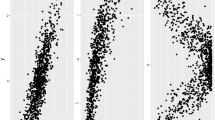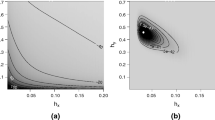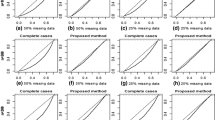A Technical appendix
1.1 A.1 Definitions
Definition 1
Let T be an interval of \(\mathbb {R}\) and \(\beta \in \left( 0,+\infty \right) \). The Hölder class on T, denoted \(\Sigma (\beta ,T)\) is the set of functions \(g:T\rightarrow \mathbb {R}\) for which there exists \(L\in \left( 0,+\infty \right) \) and \(g^{(l)}\) (with \(l=\lfloor \beta \rfloor \), denoting the largest integer less than or equal to \(\beta \)) such that \(\forall (x,x')\in T^2\), \(\left| g^{(l)}(x)-g^{(l)}(x')\right| \le L\left| x-x'\right| ^{\beta -l}\). Let
$$\begin{aligned} {\mathcal {P}(\beta )=\left\{ g\in \Sigma (\beta ,\mathbb {R})\mid g\ge 0,\int gd\lambda =1\right\} }. \end{aligned}$$
We assume exchangeability as in Section 2.1 of [3] and adopt the following definition from that paper:
Definition 2
Given \(\gamma \), let \(k,\ell \in U_\gamma \) with \(k\ne \ell \). Let
$$\begin{aligned} \mu _\gamma (y)= & {} \mathrm {E}\left[ I_{\gamma k}\mid Y_{k}=y\right] \\ v_\gamma (y)= & {} {\text {Var}}\left[ I_{\gamma k}\mid Y_{k}=y\right] \\ \mu '_\gamma (y_1,y_2)= & {} \mathrm {E}\left[ I_{\gamma k}\mid Y_{k}=y_1,Y_{\ell }=y_2\right] \\ c_\gamma (y_1,y_2)= & {} \text{ Cov }\left( I_{\gamma k},I_{\gamma \ell }\mid Y_{k}=y_1,Y_{\ell }=y_2\right) . \end{aligned}$$
(These definitions do not depend on the choice of \(k, \ell \) under the exchangeability assumption).
1.2 A.2 Assumptions
-
D0 There exist \(M:\mathbb {R}\rightarrow \mathbb {R}^+\) and \(\mu _\infty :\mathbb {R}\rightarrow \mathbb {R}^+\), both \(\lambda \)-measurable, such that
$$\begin{aligned}&\left\{ \begin{array}{l} \forall \gamma \in \mathbb {N}, \mu _\gamma<M \\ \int Mf\ d\lambda <\infty \end{array}\right. \\&\left\{ \begin{array}{l} \mu _\gamma \rightarrow \mu _\infty \text { pointwise as}~\gamma \rightarrow \infty \\ \int \mu _\infty f\,d\lambda >0. \end{array}\right. \end{aligned}$$
-
D1
$$\begin{aligned} {\text {Var}}\left[ n_\gamma \right] =o_\gamma (N_\gamma ^2). \end{aligned}$$
-
D2
$$\begin{aligned} {\left\{ \begin{array}{ll}{} \sup _{y\in \mathbb {R}} \left\{ (\mu _\gamma f)(y)\right\} =O_\gamma (1),\\ \sup _{y\in \mathbb {R}} \left\{ (\mu _\infty f)(y)\right\} <+\infty ,\\ \mu _\gamma -\mu _\infty \text { converges uniformly on a neighborhood of }y_0\text { to }0,\\ \mu _\infty \text { is continuous in }y_0,\\ f \text { is continuous in }y_0. \end{array}\right. } \end{aligned}$$
-
D3 There exists V a neighborhood of \(y_0\) such that:
$$\begin{aligned} {\left\{ \begin{array}{ll}{} \int K^2(u) \, d u<+\infty , \\ \exists v_\infty \text { a measurable real function such that }v_\gamma -v_\infty \text { converges uniformly to }0\text { on }V, \\ v_\infty \text { is continuous in }y_0, \\ \sup _{y\in \mathbb {R}} \left\{ v_\gamma (y)f(y)\right\} =O_\gamma (1), \\ \sup _{y\in \mathbb {R}} \left\{ v_\infty f(y)\right\} <+\infty ,\\ \sup _{(y_1,y_2)\in \mathbb {R}^2} \left\{ \left( d_\gamma (y_1,y_2)+c_\gamma (y_1,y_2)\right) \right\} =O_\gamma (1),\\ c_\gamma +d_\gamma \text { converges uniformly to }0\text { on }V\times V. \end{array}\right. } \end{aligned}$$
-
D4
$$\begin{aligned} {\left\{ \begin{array}{ll}{} (\rho _\gamma \times f)\in \mathscr {C}^2,\\ (\rho _\gamma \times f)^{(2)}-(\rho _\infty \times f)^{(2)}\text { converges uniformly to }0\text { on a neighborhood of }y_0,\\ \sup _{u\in \mathbb {R}}\left\{ |(\rho _\gamma \times f)^{(2)}(u)|\right\} =O_\gamma (1),\\ \int u^2K(u) \, d u<+\infty ,\\ \int u^2K(u) \, d u\ne 0, \end{array}\right. } \end{aligned}$$
where \(\mathscr {C}^2\) is the space of twice differentiable and continuous functions.
1.3 A.3 Preliminary results
Result 1
\(\forall y_0\in \mathbb {R}\),
$$\begin{aligned} {\text {Var}}\left[ \frac{n_\gamma }{\mathrm {E}\left[ n_\gamma \right] }p_\gamma (y_0)\right]\le & {} \frac{\sup _{y\in \mathbb {R}}\{(v_\gamma \times f)(y)\}+\sup _{y\in \mathbb {R}}\{(\mu _\gamma \times f)(y)\}\int K^2d\lambda }{N_\gamma h_\gamma \left( \int \mu _\gamma f d\lambda \right) ^2}\\&+\,\frac{1}{\left( \int \mu _\gamma f d\lambda \right) ^2}\sup _{(y_1,y_2)\in \mathbb {R}^2}\{(c_\gamma (y_1,y_2)f(y_1)f(y_2))\}\\&+\,\frac{1}{\left( \int \mu _\gamma f d\lambda \right) ^2}\sup _{(y_1,y_2)\in \mathbb {R}^2}\\&\times \left\{ \left( \mu '_\gamma (y_2,y_1)-\mu _\gamma (y_1)\mu _\gamma (y_2)\right) f(y_1)f(y_2))\right\} . \end{aligned}$$
Proof of Result 1
$$\begin{aligned}&{{\text {Var}}\left[ \frac{n_\gamma }{N_\gamma \int \mu _\gamma fd\lambda }p_\gamma (y_0)\right] }\\= & {} {\text {Var}}\left[ \frac{1}{h_\gamma N_\gamma \int \mu _\gamma f\,d\lambda } \sum _{k=1}^{N_\gamma }K\left( \frac{y_k-y_0}{h_\gamma }\right) I_{\gamma k}\right] \\= & {} \frac{1}{N_\gamma \left( h_\gamma \int \mu _\gamma fd\lambda \right) ^2}{\text {Var}}\left[ K\left( \frac{y_1-y_0}{h_\gamma }\right) I_{\gamma 1}\right] \\&\quad +\,\frac{N_\gamma -1}{N_\gamma \left( h_\gamma \int \mu _\gamma fd\lambda \right) ^2} Cov\left[ K\left( \frac{y_1-y_0}{h_\gamma }\right) I_{\gamma 1},K\left( \frac{y_2-y_0}{h_\gamma }\right) I_{\gamma 2}\right] \\= & {} \frac{1}{N_\gamma \left( h_\gamma \int \mu _\gamma fd\lambda \right) ^2} \left( \int K\left( \frac{y-y_0}{h_\gamma }\right) v_\gamma (y)f(y)d\lambda (y)\right. \\&+\,\int K^2\left( \frac{y-y_0}{h_\gamma }\right) m^2_\gamma (y)f(y)d\lambda (y) \\&-\,\left. \left( \int K\left( \frac{y-y_0}{h_\gamma }\right) \mu _\gamma (y)f(y)d\lambda (y)\right) ^2 \right) \\&+\,\frac{N_\gamma -1}{N_\gamma \left( h_\gamma \int \mu _\gamma fd\lambda \right) ^2} \left( \int K\left( \frac{y_1-y_0}{h_\gamma }\right) K\left( \frac{y_2-y_0}{h_\gamma }\right) \right. \\&\times \left. c_\gamma (y_1,y_2)f(y_1)f(y_2)d\lambda (y_1) d\lambda (y_2)\right. \\&+\,\int K\left( \frac{y_1-y_0}{h_\gamma }\right) K\left( \frac{y_2-y_0}{h_\gamma }\right) \left( \mu '_\gamma (y_1,y_2)\mu '_\gamma (y_2,y_1)\right. \\&\left. \left. -\,\mu _\gamma (y_1)\mu _\gamma (y_2)\right) f(y_1)f(y_2) d\lambda (y_1) d\lambda (y_2)\right) . \end{aligned}$$
\(\square \)
A kernel is of order l if \(\int u^lK(u)\,du\ne 0\) and \(\int u^jK(u)\,du=0\) for \(j=1,\ldots ,l-1\). In this paper, our kernels are typically symmetric pdf’s with mean zero and finite, non-zero second moment, so the order is \(l=2\). The following result is stated more generally, and in particular allows for kernels that need not be pdf’s.
Result 2
Assume that K is a kernel of order l such that \(\int \left| u\right| ^{\beta }\left| K(u)\right| du <+\infty \). If \(\rho _\gamma f\in \mathcal {P}(\beta )\), then
$$\begin{aligned} \forall y_0\in \mathbb {R},\ \forall \gamma \in \mathbb {N},\ \left| \mathrm {E}\left[ \frac{n_\gamma }{\mathrm {E}\left[ n_\gamma \right] }p_\gamma (y_0)\right] -\rho _\gamma (y_0)f(y_0)\right| \le C_2h_\gamma ^\beta , \end{aligned}$$
with \(C_2=\frac{L}{l!}\int |u|^\beta |K(u)|\, du\).
Proof of Result 2
$$\begin{aligned}&{\mathrm {E}\left[ \frac{n_\gamma }{\mathrm {E}\left[ n_\gamma \right] }p_\gamma (y_0)\right] -\rho _\gamma (y_0)f(y_0)}\\&\quad =\mathrm {E}\left[ \frac{n_\gamma }{N_\gamma \int \mu _\gamma f d\lambda }p_\gamma (y_0)\right] -\rho _\gamma (y_0)f(y_0)\\&\quad =\frac{1}{h_\gamma }\int K\left( \frac{y-y_0}{h_\gamma }\right) (\rho _\gamma \times f)(y)\, d y-(\rho _\gamma \times f)(y_0)\\&\quad =\int K(u)\left( (\rho _\gamma \times f)(y_0+uh_\gamma )-(\rho _\gamma \times f)(y_0)\right) \, d u. \end{aligned}$$
In addition, \(\exists \tau _\gamma :u\mapsto [0,1]\) such that:
$$\begin{aligned} (\rho _\gamma \times f)(y_0+uh_\gamma ) =\sum _{j=0}^{l-1}\frac{(\rho _\gamma \times f)^{(j)}(y_0)(uh_\gamma )^j}{j!} +\frac{(\rho _\gamma \times f)^{(l)}(y_0+\tau _\gamma (u)uh_\gamma )(uh_\gamma )^l}{l!}. \end{aligned}$$
As K is of order \(l=\lfloor \beta \rfloor \),
$$\begin{aligned}&{\mathrm {E}\left[ \frac{n_\gamma }{\mathrm {E}\left[ n_\gamma \right] }p_\gamma (y_0)\right] -\rho _\gamma (y_0)f(y_0)}\\&\quad =\int K(u)\frac{(u h_\gamma )^l}{l!}\left( (\rho _\gamma \times f)^{(l)}(y_0+\tau _\gamma (u)uh_\gamma ) -(\rho _\gamma \times f)^{(l)}(y_0)\right) \, d u, \end{aligned}$$
and
$$\begin{aligned}&{\left| \mathrm {E}\left[ \frac{n_\gamma }{\mathrm {E}\left[ n_\gamma \right] }p_\gamma (y_0)\right] -\rho _\gamma (y_0)f(y_0)\right| }\\&\quad \le \int |K(u)|\frac{|uh|^l}{l!}\left| (\rho _\gamma \times f)^{(l)}(y_0+\tau _\gamma (u)uh_\gamma ) -(\rho _\gamma \times f)^{(l)}(y_0)\right| \, d u\\&\quad \le L\int |K(u)|\frac{|uh|^l}{l!}\left| \tau _\gamma (u)uh_\gamma \right| ^{\beta -l}\, d u\\&\quad \le C_2h_\gamma ^\beta . \end{aligned}$$
\(\square \)
Result 3
If \(f\in \mathcal {P}(\beta )\), then
$$\begin{aligned}&{\sup _{y_0\in \mathbb {R}} \mathrm {E}\left[ \left( \frac{n_\gamma }{\mathrm {E}\left[ n_\gamma \right] }p_\gamma (y_0)-(\rho _\gamma \times f)(y_0)\right) ^2\right] }\\&\le \frac{\sup _{y\in \mathbb {R}}\{(v_\gamma \times f)(y)\}+\sup _{y\in \mathbb {R}}\{(\mu _\gamma \times f)(y)\}\int K^2\, d \lambda }{N_\gamma h_\gamma \left( \int \mu _\gamma f \, d \lambda \right) ^2}\\&\quad +\frac{1}{\left( \int \mu _\gamma f \, d \lambda \right) ^2}\sup _{(y_1,y_2)\in \mathbb {R}^2}\{(c_\gamma (y_1, y_2)f(y_1)f(y_2))\}\\&\quad +\frac{1}{\left( \int \mu _\gamma f \, d \lambda \right) ^2} \sup _{(y_1,y_2)\in \mathbb {R}^2}\{\left( \mu '_\gamma (y_2, y_1)-\mu _\gamma (y_1)\mu _\gamma (y_2)\right) f(y_1)f(y_2))\}\\&\quad +C_2^2h_\gamma ^{2\beta }. \end{aligned}$$
Proof of Result 3
Let \(y_0\in \mathbb {R}\), \(\gamma \in \mathbb {N}\). Then by Results 1 and 2,
$$\begin{aligned}&{\mathrm {E}\left[ \left( \frac{n_\gamma }{\mathrm {E}\left[ n_\gamma \right] }p_\gamma (y_0)-(\rho _\gamma \times f)(y_0)\right) ^2\right] }\\&\quad \le {\text {Var}}\left[ \frac{n_\gamma }{\mathrm {E}\left[ n_\gamma \right] }p_\gamma (y_0)\right] +\left| \mathrm {E}\left[ \frac{n_\gamma }{\mathrm {E}\left[ n_\gamma \right] }p_\gamma (y_0)\right] -\rho _\gamma (y_0)f(y_0)\right| ^2\\&\quad \le \frac{\sup _{y\in \mathbb {R}}\{(v_\gamma \times f)(y)\}+\sup _{y\in \mathbb {R}}\{(\mu _\gamma \times f)(y)\}\int K^2\, d \lambda }{N_\gamma h_\gamma \left( \int \mu _\gamma f \, d \lambda \right) ^2}\\&\quad \quad +\frac{1}{\left( \int \mu _\gamma f \, d \lambda \right) ^2}\sup _{(y_1,y_2)\in \mathbb {R}^2}\{(c_\gamma (y_1, y_2)f(y_1)f(y_2))\}\\&\quad \quad +\frac{1}{\left( \int \mu _\gamma f \, d \lambda \right) ^2} \sup _{(y_1,y_2)\in \mathbb {R}^2}\{\left( \mu '_\gamma (y_2, y_1)-\mu _\gamma (y_1)\mu _\gamma (y_2)\right) f(y_1)f(y_2))\}\\&\quad \quad +C_2^2h_\gamma ^{2\beta }. \end{aligned}$$
\(\square \)
1.4 A.4 Proofs of Section 2 results.
Proof of Theorem 1:
Bochner’s lemma under informative sampling. We calculate:
$$\begin{aligned}&{\left| \frac{1}{h_\gamma } \int Q\left( \frac{y-y_0}{h_\gamma } \right) r_\gamma (y)f(y)\, d \lambda (y)-g(y_0)r_\gamma (y_0)\int Q(u) \, d \lambda (u) \right| \quad \quad \quad }\\&\quad =\left| \int \left( (g\times r_\gamma )(y_0+uh_\gamma )-(g\times r)(y_0)\right) Q(u) \, d \lambda (u)\right| \\&\quad \le \sup _{|u|\le h_\gamma ^{-1/2}}\left\{ \left| (g\times r_\gamma )(y_0+uh_\gamma )-(g\times r)(y_0)\right| \right\} \int \left| Q\right| (u) \, d \lambda (u)\\&\quad \quad + \int _{|u|> h_\gamma ^{-1/2}} \left| (g\times r_\gamma )(y_0+uh_\gamma )-(g\times r)(y_0)\right| \left| Q\right| (u) \, d \lambda (u)\\&\quad \le \sup _{|v|\le h_\gamma ^{1/2}}\left\{ \left| (g\times r_\gamma )(y_0+v)-(g\times r)(y_0)\right| \right\} \int \left| Q\right| (u) \, d \lambda (u)\\&\quad \quad + \left( \sup _{u\in \mathbb {R}}\left\{ (g\times r_\gamma )(u)\right\} +\sup _{u\in \mathbb {R}}\left\{ (g\times r)(u)\right\} \right) \int _{|u|> h_\gamma ^{-1/2}}\left| Q\right| (u) \, d \lambda (u) \end{aligned}$$
$$\begin{aligned}&\le \left( \sup _{|v|\le h_\gamma ^{1/2}}\left\{ \left| (g\times r_\gamma )(y_0+v)-(g\times r)(y_0+v)\right| \right\} \right. \\&\quad \quad \left. +\sup _{|v|\le h_\gamma ^{1/2}}\left\{ \left| (g\times r)(y_0+v)-(g\times r)(y_0)\right| \right\} \right) \int \left| Q\right| (u) \, d \lambda (u)\\&\quad \quad + \left( \sup _{u\in \mathbb {R}}\left\{ (g\times r_\gamma )(u)\right\} +\sup _{u\in \mathbb {R}}\left\{ (g\times r)(u)\right\} \right) \int _{|u|> h_\gamma ^{-1/2}}\left| Q\right| (u) \, d \lambda (u) \end{aligned}$$
$$\begin{aligned}&\quad \le \left( \sup _{|v|\le h_\gamma ^{1/2}}\left\{ \left| (r_\gamma -r)(y_0+v)\right| \right\} \sup _{|v|\le h_\gamma ^{1/2}}\left\{ \left| g(y_0+v)\right| \right\} \right. \\&\quad \quad \left. +\sup _{|v|\le h_\gamma ^{1/2}}\left\{ \left| (g\times r)(y_0+v)-(g\times r)(y_0)\right| \right\} \right) \int \left| Q\right| (u) \, d \lambda (u)\\&\quad \quad + \left( \sup _{u\in \mathbb {R}}\left\{ (g\times r_\gamma )(u)\right\} +\sup _{u\in \mathbb {R}}\left\{ (g\times r)(u)\right\} \right) \int _{|u|> h_\gamma ^{-1/2}}\left| Q\right| (u) \, d \lambda (u). \end{aligned}$$
When \(h_\gamma \rightarrow 0\) every summand tends to 0. \(\square \)
Proof of Theorem 2
We calculate:
$$\begin{aligned}&{\left| \frac{1}{h_\gamma ^2}\int Q\left( \frac{y_1-y_0}{h_\gamma }\right) Q\left( \frac{y_2-y_0}{h_\gamma }\right) r_\gamma (y_1,y_2)g(y_1)g(y_2) \, d y_1 \, d y_2 \right| \quad \quad \quad \quad \quad \quad }\\&\quad =\left| \int Q\left( y_0+u_1h_\gamma \right) Q\left( y_0+u_2h_\gamma \right) \right. \\&\qquad \left. r_\gamma (y_0+u_1h_\gamma ,y_0+u_2h_\gamma )g(y_0+u_1h_\gamma )g(y_0+u_2h_\gamma ) \, d u_1 \, d u_2 \phantom {\frac{1}{2}}\right| \\&\quad \le \sup _{\max (u_1,u_2)\le h_\gamma ^{-1/2}} \left\{ \left| g(y_0+u_1h_\gamma )g(y_0+u_2h_\gamma ) r_\gamma (y_0+u_1h_\gamma ,y_0+u_2h_\gamma )\right| \right\} \\&\qquad \left( \int \left| Q\right| (u) \, d u\right) ^2 +\sup _{(u_1,u_2)\in \mathbb {R}^2}\left\{ \left| g(u_1)g(u_2) r_\gamma (u_1,u_2)\right| \right\} \left( \int _{u> h_\gamma ^{-1/2}}\left| Q\right| (u) \, d u\right) ^2\\&\quad \le \sup _{\max (v_1,v_2)\le h_\gamma ^{1/2}} \left\{ \left| g(y_0+v_1)g(y_0+v_2) r_\gamma (y_0+v_1,y_0+v_2)\right| \right\} \left( \int \left| Q\right| (u) \, d u\right) ^2\\&\quad \quad +\sup _{(u_1,u_2)\in \mathbb {R}^2}\left\{ \left| g(u_1)g(u_2) r_\gamma (u_1,u_2)\right| \right\} \left( \int _{u> h_\gamma ^{-1/2}}\left| Q\right| (u) \, d u\right) ^2. \end{aligned}$$
When \(h_\gamma \rightarrow 0\) every summand tends to 0. \(\square \)
Proof of Proposition 1
With D0, as \(\lim _{\gamma \rightarrow \infty } \int \mu _\gamma f>0\), then \(\exists \Gamma \in \mathbb {N}\) such that \(\forall \gamma \in \mathbb {N}\), \(\gamma \ge \Gamma \Rightarrow \mathrm {E}\left[ n_\gamma \right] >0\). Then,
$$\begin{aligned} \mathrm {E}\left[ \frac{n_\gamma }{N_\gamma \int \mu _\gamma f} p_\gamma (y_0)\right]= & {} \left( \frac{1}{\int \mu _\gamma f}+o_\gamma (1)\right) \frac{1}{h_\gamma } \int K\left( \frac{y-y_0}{h_\gamma }\right) \mu _\gamma (y)f(y) \, d \lambda (y). \end{aligned}$$
We apply Theorem 1 with \(g=f\), \(r_\gamma =\mu _\gamma \), \(r=\mu _\infty \), and obtain that:
$$\begin{aligned} \lim _{\gamma \rightarrow \infty } \mathrm {E}\left[ \frac{n_\gamma }{\mathrm {E}\left[ n_\gamma \right] }p_\gamma (y_0)\right] =\rho _\infty (y_0)f(y_0). \end{aligned}$$
Besides,
$$\begin{aligned} p_\gamma (y_0)-\frac{n_\gamma }{\mathrm {E}\left[ n_\gamma \right] }p_\gamma (y_0)= \left( \frac{\mathrm {E}\left[ n_\gamma \right] }{n_\gamma +\mathbb {1}_{\{0\}}(n_\gamma )}-1\right) \frac{n_\gamma }{\mathrm {E}\left[ n_\gamma \right] }p_\gamma (y_0), \end{aligned}$$
and with D1, \(\mathrm {E}\left[ \left( \frac{\mathrm {E}\left[ n_\gamma \right] }{n_\gamma +\mathbb {1}_{\{0\}}(n_\gamma )}-1\right) ^{2}\right] =o_\gamma (1)\). \(\square \)
Proof of Proposition 2
We calculate:
$$\begin{aligned}&{{\text {Var}}\left[ \frac{1}{h_\gamma N_\gamma \int \mu _\gamma f \, d \lambda } \sum _{k=1}^{N_\gamma }K\left( \frac{y_k-y_0}{h_\gamma }\right) I_{\gamma k}\right] }\\&\quad =\frac{1}{N_\gamma \left( \int \mu _\gamma f\, d \lambda \right) ^2} \left( \frac{1}{h_\gamma ^2}\int K\left( \frac{y-y_0}{h_\gamma }\right) v_\gamma (y)f(y)\, d \lambda (y)\right. \\&\quad \quad +\frac{1}{h_\gamma ^2}\int K^2\left( \frac{y-y_0}{h_\gamma }\right) \mu ^2_\gamma (y)f(y)\, d \lambda (y) \\&\quad \quad -\left. \left( \frac{1}{h_\gamma } \int K\left( \frac{y-y_0}{h_\gamma }\right) \mu _\gamma (y)f(y)\, d \lambda (y)\right) ^2 \right) \\&\quad \quad +\frac{N_\gamma -1}{N_\gamma \!\left( \!h_\gamma \int \mu _\gamma f\, d \lambda \right) ^2} \left( \!\int \! K\!\left( \!\frac{y_1-y_0}{h_\gamma }\!\right) \!K\!\left( \!\frac{y_2-y_0}{h_\gamma }\!\right) \right. \\&\quad \times \left. (c_\gamma +\, d _\gamma )(y_1,y_2)f(y_1)f(y_2)\, d \lambda (y_1) \, d \lambda (y_2)\!\right) . \end{aligned}$$
By application of Theorem 1 to \(Q=K\), \(r_\gamma =v_\gamma \), and \(r=v_\infty \), we obtain that:
$$\begin{aligned} \frac{1}{h_\gamma }\int K\left( \frac{y-y_0}{h_\gamma } \right) v_\gamma (y)f(y)\, d \lambda (y)=v_\infty (y_0)f(y_0)+o_\gamma (1). \end{aligned}$$
By application of Theorem 1 to \(Q=K\), \(r_\gamma =\mu _\gamma \), and \(m=v\), we obtain that:
$$\begin{aligned} \frac{1}{h_\gamma }\int K\left( \frac{y-y_0}{h_\gamma } \right) \mu _\gamma (y)f(y)\, d \lambda (y)=\mu _\infty (y_0)f(y_0)+o_\gamma (1). \end{aligned}$$
By application of Theorem 2 to \(Q=K\), and \(r_\gamma =(c_\gamma +\, d _\gamma )\), we obtain that:
$$\begin{aligned} \frac{1}{\left( h_\gamma \right) ^2}\left( \int K\left( \frac{y_1{-}y_0}{h_\gamma }\right) K\left( \frac{y_2{-}y_0}{h_\gamma }\right) (c_\gamma {+} d _\gamma )(y_1,y_2)f(y_1)f(y_2) d \lambda (y_1) d \lambda (y_2)\right) {=}o_\gamma (1). \end{aligned}$$
So
$$\begin{aligned}&{\text {Var}}\left[ \frac{1}{h_\gamma N_\gamma \int \mu _\gamma f \, d \lambda } \sum _{k=1}^{N_\gamma }K\left( \frac{y_k-y_0}{h_\gamma }\right) I_{\gamma k}\right] \\&\quad = \frac{1}{N_\gamma h_\gamma \left( \int \mu _\gamma f\, d \lambda \right) ^2}\left( v(y_0)f(y_0)+o_\gamma (1)\right) \\&\quad \quad +\frac{1}{N_\gamma h_\gamma }\left( \rho _\infty ^2(y_0)f(y_0)\int K^2(u)\, d u\right) (1+o_\gamma (1))\\&\quad \quad +\frac{1}{N_\gamma }\left( \rho _\infty ^2(y_0)f^2(y_0)+o_\gamma (1)\right) +o_\gamma (1). \end{aligned}$$
Thus
$$\begin{aligned} {\text {Var}}\left[ \frac{n_\gamma }{\mathrm {E}\left[ n_\gamma \right] }p_\gamma (y)\right] \sim _\gamma \frac{f(y_0)}{N_\gamma h_\gamma }\left( \left( \frac{v(y_0)}{\left( \int \mu _\infty f\, d \lambda \right) ^2}+\rho _\infty ^2(y_0)\right) \int K^2(u)\, d u\right) \end{aligned}$$
and by D1, \(\mathrm {E}\left[ \left( \frac{n_\gamma }{\mathrm {E}\left[ n_\gamma \right] }-1\right) ^2\right] =o_\gamma (1),\) which together with the preceding implies the result. \(\square \)
Proof of Proposition 3
We use the calculations of Result 2 with \(l=2\), and the fact that K is a kernel of order \(l=2\): \(\exists \tau _\gamma :u\mapsto [0,1]\) such that:
$$\begin{aligned} \mathrm {E}\left[ \frac{n_\gamma }{\mathrm {E}\left[ n_\gamma \right] }p_\gamma (y_0)\right] -\rho _\gamma (y_0)f(y_0)= & {} \int K(u)\frac{(uh_\gamma )^2}{2}(\rho _\gamma \times f)^{(2)}(y_0+\tau (u)uh_\gamma )\, d u\\= & {} \frac{h_\gamma ^2}{2}(\rho _\gamma \times f)^{(2)}(y_0)\int u^2K(u)\, d u+\Delta _\gamma (u), \end{aligned}$$
with
$$\begin{aligned} \Delta _\gamma (u)= & {} \int u^2K(u)\left( (\rho _\gamma \times f)^{(2)}(y_0+\tau _\gamma (u)uh_\gamma )-(\rho _\gamma \times f)^{(2)}(y_0)\right) \, d u\\ |\Delta _\gamma (u)|\le & {} \sup _{u\le h_\gamma ^{-1/2}}\left\{ \left| (\rho _\gamma \times f)^{(2)}(y_0+\tau _\gamma (u)uh_\gamma )-(\rho _\gamma \times f)^{(2)}(y_0)\right| \right\} \int u^2K(u)\, d u\\&+2\sup _{u\in \mathbb {R}}\left\{ |(\rho _\gamma \times f)^{(2)}(u)|\right\} \int _{u>h_\gamma ^{-1/2}} u^2K(u)\, d u\\\le & {} \sup _{v\le h_\gamma ^{1/2}}\left\{ \left| (\rho _\gamma \times f)^{(2)}(y_0+v)-(\rho _\gamma \times f)^{(2)}(y_0)\right| \right\} \int u^2K(u)\, d u\\&+2\sup _{u\in \mathbb {R}}\left\{ |(\rho _\gamma \times f)^{(2)}(u)|\right\} \int _{u>h_\gamma ^{-1/2}} u^2K(u)\, d u\\= & {} O_\gamma (h_\gamma ). \end{aligned}$$
Then
$$\begin{aligned} \mathrm {E}\left[ \frac{n_\gamma }{\mathrm {E}\left[ n_\gamma \right] }p_\gamma (y_0)-\rho _\infty (y_0)f(y_0)\right] = \frac{h_\gamma ^2}{2}\left( (\rho _\gamma \times f)^{(2)}(y_0)\int u^2K(u)\, d u+o_\gamma (1)\right) . \end{aligned}$$
By D1, \(\mathrm {E}\left[ \left( \frac{n_\gamma }{\mathrm {E}\left[ n_\gamma \right] }-1\right) ^2\right] =o_\gamma (1)\), and then:
$$\begin{aligned} \mathrm {E}\left[ p_\gamma (y_0)-\rho _\infty (y_0)f(y_0)\right] = \frac{h_\gamma ^2}{2}\left( (\rho _\gamma \times f)^{(2)}(y_0)\int u^2K(u)\, d u+o_\gamma (1)\right) . \end{aligned}$$
\(\square \)





